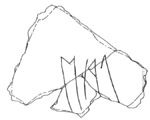JU·1 Montmorot
| Object | |
|---|---|
| Classification: | bowl |
|
| |
| Material: | pottery |
| Size: | height 8 cm, width 7.5 cm, thickness 0.5–0.7 cm (of fragment) |
| Condition: | fragmentary |
|
| |
| Archaeological culture: | Hallstatt D |
| Date: | second half of 6th c. BC |
| Date derived from: | archaeological context |
|
| |
| Site: | Montmorot (Jura, Franche-Comté, France) |
| Field name: | Colline du Château |
| Coordinates (approx.): | 46° 40' 49.48" N, 5° 31' 42.54" E |
| Find date: | 1960s |
| Find circumstances: | excavation |
| Current location: | Musée d’Archéologie (Lons-le-Saunier) |
| Inventory no.: | 2/1/C5 |
|
| |
| Inscription: | JU·1 (priś) |
|
| |
| Alternative sigla: | none |
|
| |
| Sources: | Verger 2001: 270–272 |
Images
Commentary
Images in Verger 1998: 622, fig. 3 (photo = Verger 2001: tav. XXXVIc) and 623, fig. 4 (drawings = Verger 2001: 271, fig. 3 = Kaenel 2000: 153, fig. 3).
Three adjacent fragments of a ceramic vessel, reassembled by C. Cathelinais in 1997 (Verger 2001: 270, n. 19), making up a segment of the wall near the foot of a locally made Hallstatt "jatte haute" of a type commonly found at the site in all strata (Verger 2001: 271 with detailed description). The object itself cannot therefore be precisely dated. The fragments come from the youngest prehistoric layer of the settlement, stratum I, dated to the second half of the 6th century BC (Hallstatt D1–2; Verger 2001: 272). Verger observes that, stratum I being a filling layer, the object may well be somewhat older; his dating to the end of the 7th/beginning of the 6th century BC is based on palaeography (see the inscription page).
